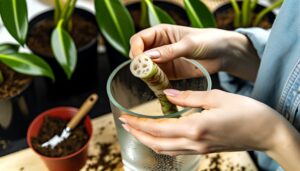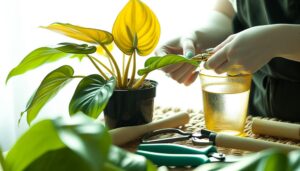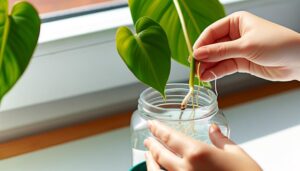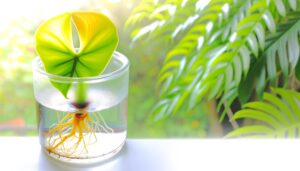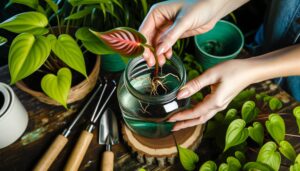Como Propagar Philodendron: A Step-by-Step Guide!
Propagating Philodendron species, such as Philodendron hederaceum, requires precise methodology. Start with sterilized pruning shears and disinfect surfaces.
Select a robust stem with multiple nodes, free of chlorotic leaves or insect damage. Make a clean cut below a node at a 45-degree angle.
Apply a rooting hormone containing indole-3-butyric acid (IBA). For water rooting, place the cutting in dechlorinated water and change it regularly.
For soil propagation, use a well-draining mix with a pH of 5.5 to 6.5, ensuring high humidity and indirect light. By maintaining these conditions, root development can be optimized.
Further details on care await.
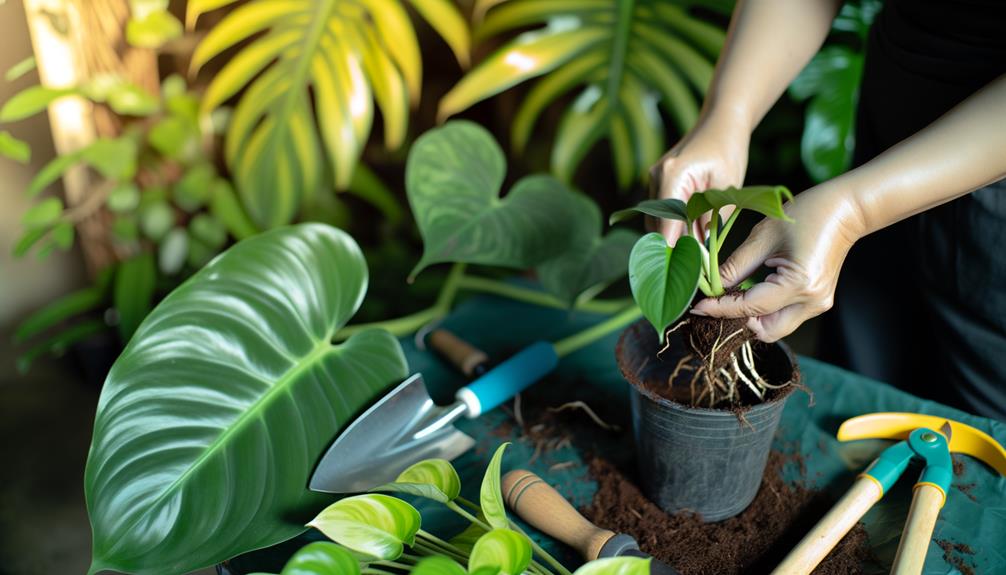
Key Takeaways
- Elige tallos sanos con múltiples nudos y raíces aéreas para una propagación más rápida.
- Usa tijeras de podar esterilizadas y aplica hormona de enraizamiento en el corte.
- Coloca los esquejes en agua desclorada, cambiándola regularmente, o en un sustrato bien drenado.
- Mantén alta humedad con un domo de humedad o una bolsa de plástico.
- Proporciona luz indirecta y monitorea el desarrollo de raíces blancas y robustas antes de trasplantar.
Choosing the Right Tools
Selecting the suitable tools is crucial for the successful propagation of Philodendron species, ensuring both the health of the parent plant and the viability of the cuttings.
To begin, a pair of sterilized, sharp pruning shears or a scalpel is indispensable for making clean cuts. The use of isopropyl alcohol (70%) for sterilization reduces the risk of pathogen transmission.
A clean, flat surface for preparing the cuttings should be used, preferably disinfected with a mild bleach solution.
Additionally, a rooting hormone containing indole-3-butyric acid (IBA) can enhance root development. Employing a humidity dome or a plastic bag to maintain high humidity levels during the initial stages of rooting is also recommended.
These tools collectively foster ideal propagation conditions.
Selecting a Healthy Stem
After assembling the necessary tools, the next step involves identifying a strong stem from the Philodendron, preferably one that exhibits robust growth and is free from any signs of disease or pest infestation.
Prioritize stems with multiple nodes, as these are crucial for root development. Make sure the selected stem belongs to a healthy Philodendron species, such as Philodendron hederaceum or Philodendron bipinnatifidum. Inspect the stem for turgidity, consistent coloration, and absence of necrotic tissue.
Avoid stems with chlorotic leaves or signs of insect damage. Selecting a stem with aerial roots can expedite the propagation process. This careful selection guarantees that the cutting has the highest potential for successful rooting and growth, thereby ensuring strong progeny.
Making the Cut
To begin the cutting process, use a sterilized, sharp blade to create a clean incision just below a node on the chosen Philodendron stem. This node, rich in meristematic tissue, is crucial for successful propagation.
The blade, sterilized with isopropyl alcohol, reduces pathogen transmission. The cut should be at a 45-degree angle to maximize the surface area, aiding in nutrient absorption.
Choose a segment around 4-6 inches long with at least two nodes. The upper node should have a few leaves to support photosynthesis. Promptly place the cutting in a sterile environment to prevent contamination.
The cut end may be treated with a rooting hormone (auxin) to encourage root development, improving the propagation efficiency of Philodendron species.
Water Rooting Method
In the water rooting method for propagating Philodendron (Philodendron spp.), it is important to select healthy cuttings with at least one node and a few leaves.
Place the cuttings in a transparent container filled with dechlorinated water to promote root growth through best exposure to light and nutrients.
Regularly change the water to prevent microbial growth and promote successful root development.
Selecting Healthy Cuttings
Selecting a healthy Philodendron cutting (Philodendron spp.) involves identifying a vine segment with at least two nodes and several strong leaves, which are crucial for successful water rooting.
The nodes are vital as they contain meristematic cells that support root development. It is recommended to use sterilized pruning shears to make a clean cut just below a node.
Key considerations for selecting an ideal cutting include:
- Node Count: Minimum of two nodes per cutting.
- Leaf Condition: Leaves should be free from discoloration and damage.
- Stem Health: Choose stems that are neither too mature nor too juvenile.
- Pest-Free: Ensure no indications of pests or diseases.
- Size: A cutting length of 4-6 inches is perfect for stability.
Promoting Root Growth
After selecting a healthy cutting with the appropriate number of nodes and leaves, the next step involves placing the cutting in a container filled with dechlorinated water to initiate the rooting process.
Utilize a glass jar to monitor root development. Make sure that at least one node is submerged, as this is the site for adventitious root formation.
Maintain water levels to keep nodes submerged, and replace the water weekly to prevent microbial growth. Position the container in indirect sunlight, as direct exposure can cause thermal stress. Roots, typically emerging within 2-4 weeks, should be white and robust before transplantation.
Philodendron hederaceum cuttings benefit from a temperature range of 20-25°C (68-77°F) for best root proliferation.
Soil Planting Technique
The soil planting technique for propagating Philodendron spp. necessitates well-draining, aerated substrate composed of equal parts peat moss, perlite, and orchid bark.
Initiate the rooting process by selecting a healthy stem cutting with at least one node and inserting it into pre-moistened soil at a depth of approximately 2-3 centimeters.
Maintain consistent humidity and indirect light conditions to facilitate best root development.
Ideal Soil Conditions
Philodendron cuttings thrive most in a well-draining potting mix composed of equal parts perlite, peat moss, and vermiculite to guarantee root development and aeration at its peak.
This specific blend ensures a prime balance between moisture retention and drainage, preventing root rot and facilitating healthy growth. The pH level should be slightly acidic, ideally between 5.5 and 6.5, to mimic natural tropical conditions.
- Perlite: Enhances drainage and aeration.
- Peat moss: Retains moisture and provides organic matter.
- Vermiculite: Improves water retention and nutrient exchange.
- pH level: Maintains an ideal range of 5.5 to 6.5.
- Sterilization: Secures the medium is free from pathogens.
Employing this precise soil mix establishes a robust foundation for successful propagation.
Rooting Process Steps
Initiating the rooting process for Philodendron cuttings involves selecting a healthy stem segment with at least two nodes and several mature leaves. Begin by making a clean incision below a node using a sterilized, sharp blade to prevent pathogen transmission.
Prepare a well-aerated, moist potting mix composed of equal parts peat moss, perlite, and vermiculite. Insert the cutting into the soil, ensuring that at least one node is submerged, as nodes are critical sites for root development.
Maintain consistent soil moisture by misting lightly, avoiding waterlogging. Place the pot in a warm, humid environment with indirect light to facilitate root initiation.
Monitor for root emergence, typically occurring within 4-6 weeks, indicating successful propagation.
Post-Propagation Care
After successful propagation, creating ideal environmental conditions such as humidity, light, and temperature is crucial for the acclimatization and continued growth of Philodendron species.
Post-propagation care involves several critical steps to promote strong root development and healthy foliage.
Key considerations include:
- Humidity: Maintain relative humidity levels between 60-80% to replicate tropical understory conditions.
- Light: Provide indirect, filtered light; avoid direct sunlight which can lead to photodamage.
- Temperature: Maintain a stable temperature range of 18-24°C (65-75°F) to support metabolic processes.
- Watering: Implement consistent, moderate watering practices; ensure the substrate remains moist but not waterlogged.
- Nutrient Management: Introduce a diluted, balanced fertilizer regimen to supply essential macro and micronutrients.
These measures collectively promote optimal growth and resilience in newly propagated Philodendrons.
Conclusion
To sum up, mastering the propagation of Philodendron spp. involves careful selection of tools and healthy stems, precise execution of cuts, and the choice between water rooting and soil planting techniques.
This process, akin to a symphony, requires harmony between each step to guarantee successful growth.
Post-propagation care, covering sufficient light, humidity, and nutrient provision, is critical for robust development.
Therefore, understanding these intricate steps is paramount for cultivating thriving Philodendron specimens.

